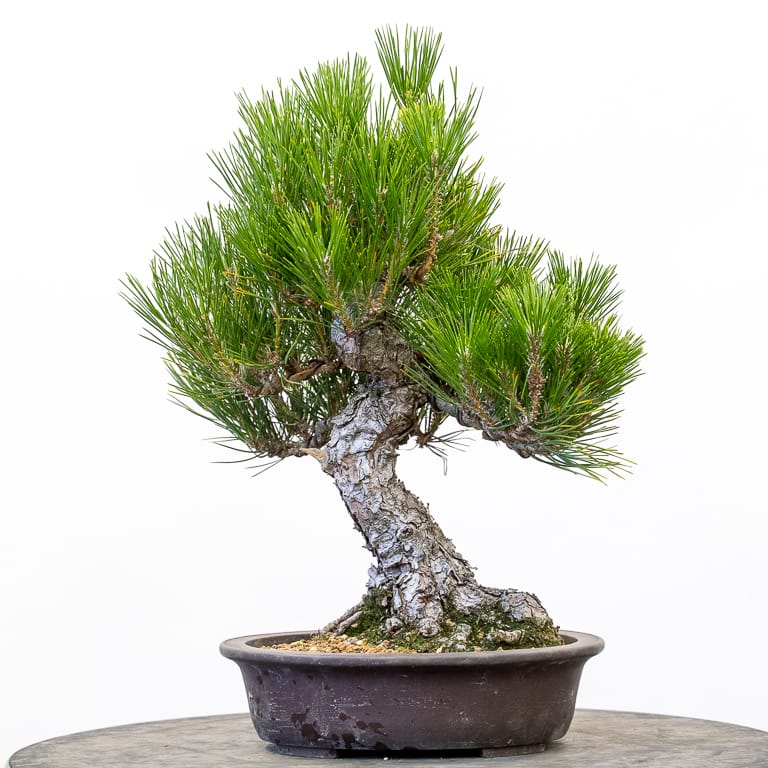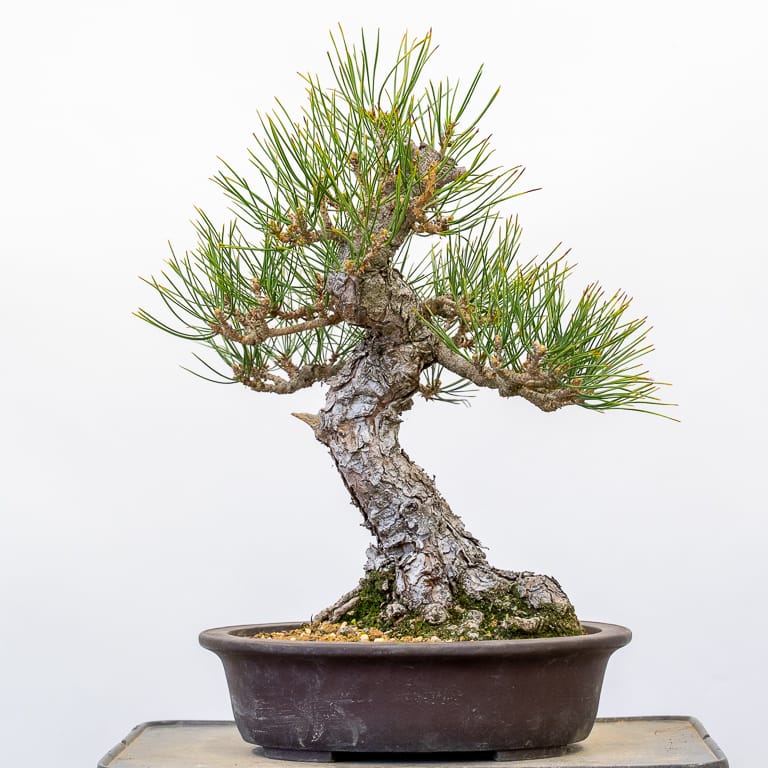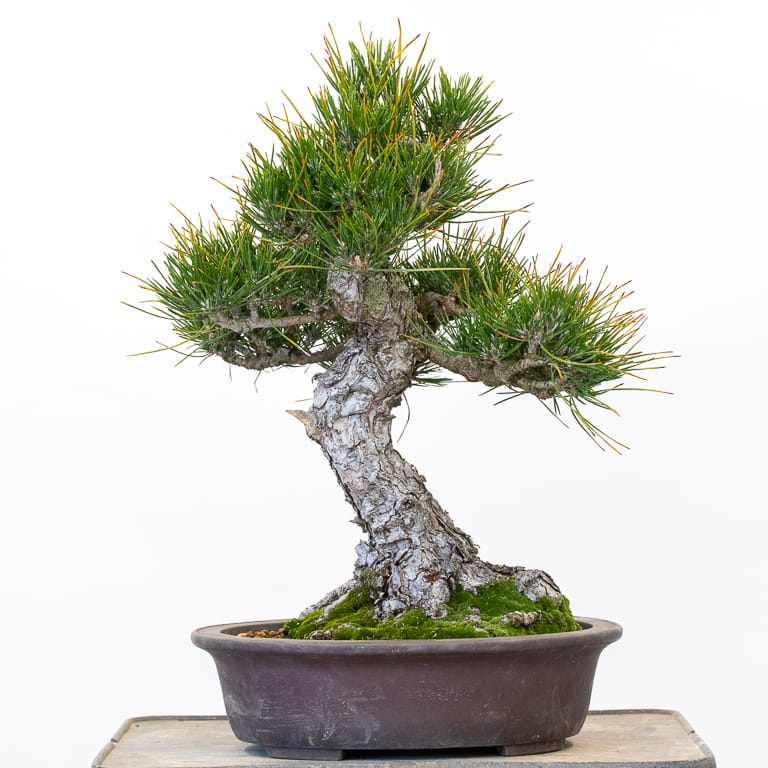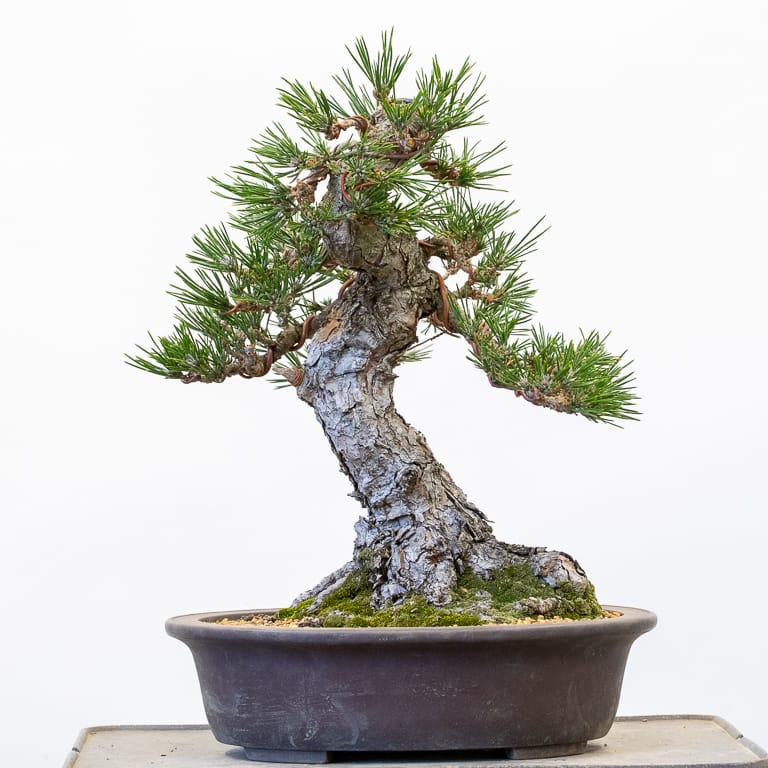It’s been fun watching the branches develop on some of the older pines I’ve grown from seed.
When these trees are healthy, it only takes a few years to reduce the internode length and fill out the basic silhouette. The main challenge at this stage is managing the tree’s vigor to reliably produce two shoots per branch after decandling.
The tree below is a good example of how much the internode length can be reduced over the course of a year. Here’s the tree before decandling last summer (see “Refining a 15 year-old pine” for photos of the previous year’s work).

Japanese black pine – June, 2020
And here’s the tree after decandling.

After decandling
Last summer, the new shoots that developed were much shorter than they were the previous year. They were shorter for two reasons: the tree was repotted, and the number of branches was much larger than it was the year before (in general, the more branches a tree has, the shorter the new shoots will be).
Now that the tree is producing short branches, I can focus on developing the silhouette. The first step is removing the old needles and thinning unnecessary branches.

February, 2021

After thinning crowded areas and removing extra needles
This gave me an opportunity to wire the primary branches.

After wiring – 13″
It’ll take a few more years for the silhouette to fill in, so I’ll look to do similar work each summer (decandling) and fall/winter (thining and wiring) going forward. Once I have a better idea about the final outline, I’ll look for a smaller pot that suits the style of the tree.
Bonsai Tonight Updates
- For the time being, I’ve switched to posting once per week (on Fridays) instead of twice a week in an effort to catch up on a variety of projects.
- As some of you have noticed, I’ve recently stopped supporting the forum, Ask Bonsai Tonight. I did this to make room for new projects like creating more video content or working on a second book. Big thanks to everyone who made the forum such a valuable resource!
- Akadama – this year’s shipment came and went quickly. More soil is on order and is expected to arrive this summer. I’ll post updates when I have more details.
Subscribe to Bonsai Tonight
New Posts Delivered Every Tuesday and Friday
Peter Grisdale says
Ooo a second book, can’t wait.
I’d like to see you do an advanced techniques book or an intermediate techniques book of either conifers or deciduous trees, would be awesome I’m sure 👍🏻
Jonas Dupuich says
Thanks, Peter – the ideas I’m working on are in that vein (resources for intermediate or advanced approaches to bonsai). Will keep at it!
Peter Grisdale says
Awesome, you’ve defo got 1 sold already 👍🏻👍🏻
Jeff S says
Hi Jonas,
Another super post. Quite often I wonder where the sacrifice branch scars are on these trees, it would be interesting to see.
It’s a shame that “Ask” is gone for now, but I completely understand – priorities! I can foresee myself taking advantage of your video consulting in the future. Looking forward to seeing the fruits of your ventures, best wishes from the UK.
Jonas Dupuich says
Thank you, Jeff! And good point about the scars. I’ll make a note to highlight the scars in an upcoming post as that can provide an idea of how the tree came together. Thanks again!
Vance hanna says
Jonas!
Just excellent information on this technique! I am looking forward to meeting you in person when I get over to that part of the state permanently (hopefully this Spring/Summer)
Thanks so much!
Vance Hanna
Jonas Dupuich says
Thanks, Vance! That sounds great about a visit – fingers crossed it’ll be sooner rather than later!
Jaye Marie says
I have a straggly pine, and this post will help me a lot!
Gerald Rainville says
Defining the top of black pine can be misunderstood and defining. You nailed it. Love the capturing of compact
Jonas Dupuich says
Thank you, Gerald!
Gabriele Monetti says
Another great post on pines, Jonas. I think your next book should narrow down on that species..:) I would be the first to buy it.
On that topic, I’m reading through some of your historical blog entries that explain what to do after decandling and it refers to thinning buds in the summer, approx. one to two months after decandling, when the buds are about the size of a grain of rice. I thought thinning buds (ideally down to two) was a fall activity when we thin needles; at that time the buds are definitely much larger than a grain of rice. Are we talking about two complementary techniques? Gabe
Jonas Dupuich says
Ha – thanks, Gabe! I don’t typically thin small buds in summer. It’s a relatively common technique, and I’m experimenting with it this year, but I’ve done very little of it over the years. In general I wait, as you noted, until fall/winter when I trim back to two buds.